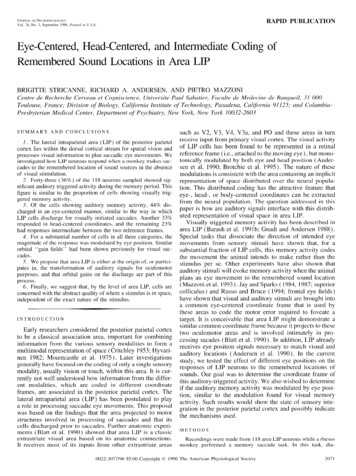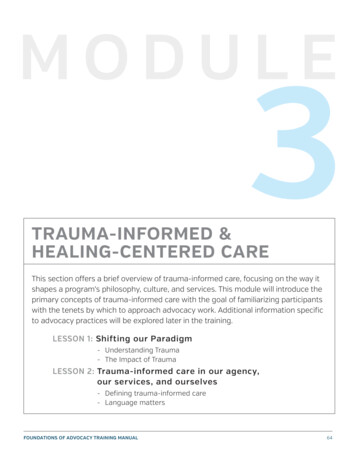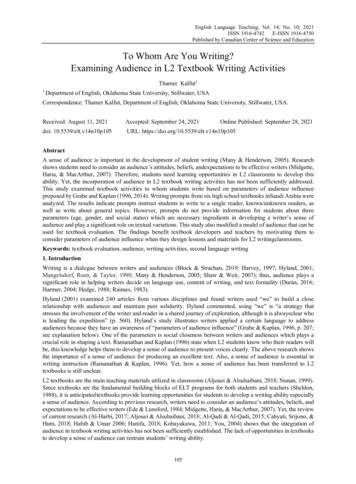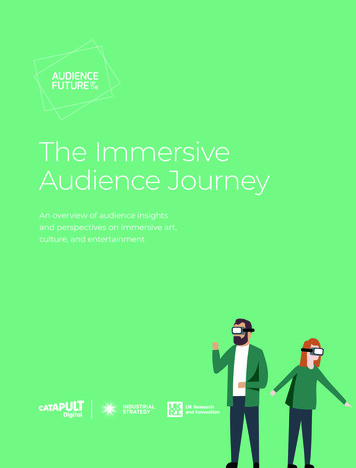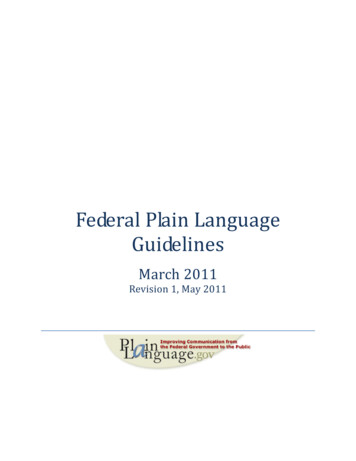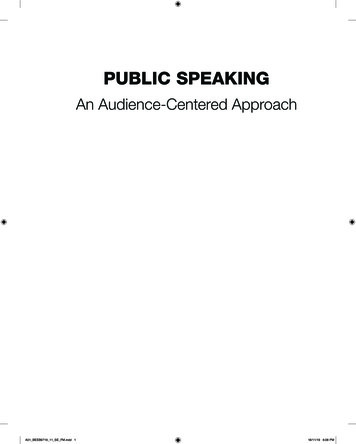
Transcription
PUBLIC SPEAKINGAn Audience-Centered ApproachA01 BEEB9719 11 SE FM.indd 118/11/19 6:08 PM
A01 BEEB9719 11 SE FM.indd 218/11/19 6:08 PM
PUBLIC SPEAKINGAn Audience-Centered ApproachEleventh EditionSteven A. BeebeTexas State UniversitySusan J. BeebeTexas State UniversityA01 BEEB9719 11 SE FM.indd 318/11/19 6:08 PM
Please contact pport with any queries on this content.Copyright 2021, 2018, 2015, 2012 by Pearson Education, Inc. or its affiliates. All Rights Reserved. Printed in theUnited States of America. This publication is protected by copyright, and permission should be obtained from the publisher prior to any prohibited reproduction, storage in a retrieval system, or transmission in any form or by any means,electronic, mechanical, photocopying, recording, or otherwise. For information regarding permissions, request formsand the appropriate contacts within the Pearson Education Global Rights & Permissions department, please visit www.pearsoned.com/permissions/.Acknowledgements of third party content appear within the text or on page 348, which constitutes an extension of thiscopyright page.Cover Design: Lumina Datamatics, Inc.Cover Illustration: Greg BetzaPEARSON, ALWAYS LEARNING, and REVEL are exclusive trademarks owned by Pearson Education, Inc. or itsaffiliates, in the U.S. and/or other countries.Unless otherwise indicated herein, any third-party trademarks that may appear in this work are the property of theirrespective owners and any references to third-party trademarks, logos or other trade dress are for demonstrative ordescriptive purposes only. Such references are not intended to imply any sponsorship, endorsement, authorization,or promotion of Pearson’s products by the owners of such marks, or any relationship between the owner and PearsonEducation, Inc. or its affiliates, authors, licensees or distributors.Library of Congress Cataloging-in-Publication DataNames: Beebe, Steven A., author. Beebe, Susan J., author.Title: Public speaking: an audience-centered approach / Steven A. Beebe, Texas State University,Susan J. Beebe, Texas State University.Description: Eleventh edition. Hoboken: Pearson, [2019]Identifiers: LCCN 2019013334 ISBN 9780135709719 ISBN 0135709717Subjects: LCSH: Public speaking. Oral communication.Classification: LCC PN4129.15 .B43 2019 DDC 808.5/1—dc23LC record available at https://lccn.loc.gov/2019013334Revel Access Code CardISBN 10:0-13-530499-7ISBN 13: 978-0-13-530499-0ScoutAutomatedPrintCodeRental EditionISBN 10:0-13-570971-7ISBN 13: 978-0-13-570971-9Instructor’s Review CopyISBN 10: 0-13-570538-XISBN 13: 978-0-13-570538-4A01 BEEB9719 11 SE FM.indd 418/11/19 6:08 PM
Dedicated to our parents, Russell and Muriel Beebe and Herb and Jane DyeTo our children, Mark and Amanda Beebe and Matt and Kara BeebeAnd to our granddaughter, Mary JensenA01 BEEB9719 11 SE FM.indd 518/11/19 6:08 PM
A01 BEEB9719 11 SE FM.indd 618/11/19 6:08 PM
Brief Contents1Speaking with Confidence2Presenting Your First Speech193Speaking Freely and Ethically354Listening to Speeches475Analyzing Your Audience676Developing Your Speech957Gathering and Using Supporting Material1138Organizing and Outlining Your Speech1299Introducing and Concluding Your Speech15410Using Words Well: Speaker Language and Style16711Delivering Your Speech17912Using Presentation Aids20413Speaking to Inform22314Understanding Principles of Persuasive Speaking24015Using Persuasive Strategies25916Speaking for Special Occasions and Purposes290Appendix A Speaking in Small Groups305Appendix BMediated Public Speaking311Appendix CSpeeches for Analysis and Discussion3181viiA01 BEEB9719 11 SE FM.indd 718/11/19 6:08 PM
A01 BEEB9719 11 SE FM.indd 818/11/19 6:08 PM
ContentsPreface xvAcknowledgments13xxvSpeaking with Confidence 11.1 What Is Public Speaking?2Public Speaking Today: Is Mediated CommunicationPublic Speaking? 31.2 Why Study Public Speaking?EmpowermentEmployment4441.3 The Rich Heritage of Public SpeakingThe Golden Age of Public SpeakingNineteenth- and Twentieth-Century Age of Political OratoryThe Technological Age of Public Speaking551.4 The Communication ProcessCommunication as ActionCommunication as InteractionCommunication as Transaction7789661.5 Improving Your Confidence as a SpeakerUnderstand Your NervousnessHow to Build Your Confidence101013Study Guide: Review, Apply, and Assess 172Speaking Freely and Ethically 353.1 Speaking FreelyFree Speech and the LawFree Speech and the CourtsFree Speech and Popular MovementsFree Speech and the Internetand Social Media373838383.2 Speaking EthicallyHave a Clear, Responsible GoalUse Sound Evidence and ReasoningBe Sensitive to and Tolerantof DifferencesBe HonestDo Not Plagiarize40404039414242Public Speaking Today: Ethical Responsibilities WhenUsing Social Media 43Sample Oral Citation 453.3 Speaking Credibly45Study Guide: Review, Apply, and Assess 464Listening to Speeches 4.1 Overcoming Barriers to Effective ListeningListener FatiguePersonal Concerns47494950Presenting Your First Speech 192.1 Consider Your AudienceGather and Analyze Information about YourAudienceConsider the Culturally Diverse Backgrounds ofYour Audience20Public Speaking Today: Listening to MediatedMessages 50212.2 The Audience-Centered Speechmaking ProcessSelect and Narrow Your TopicDetermine Your PurposeDevelop Your Central IdeaGenerate the Main IdeasGather Supporting Material222324252626Outside Distractions 51Prejudice 51Differences between Speech Rateand Thought Rate 52Public Speaking Today: Get Technical Support BeforeYou Need It 28224.2 How to Become a Better ListenerListen with Your Eyes as Well asYour EarsListen MindfullyListen SkillfullyListen Ethically534.3 Improving Critical Listening and Thinking SkillsSeparate Facts from InferencesEvaluate the Quality of Evidence596060Sample Speech: Conquering Your Fear of Public Speaking 334.4 Analyzing and Evaluating SpeechesGiving Feedback to OthersGiving Feedback to Yourself616164Study Guide: Review, Apply, and Assess Study Guide: Review, Apply, and Assess 65Organize Your Speech Rehearse Your Speech Sample Outline Deliver Your Speech 282930313453545658ixA01 BEEB9719 11 SE FM.indd 918/11/19 6:08 PM
x Contents 5Analyzing Your Audience 675.1 Gathering Information about Your AudienceGathering Information InformallyGathering Information Formally6969695.2 Analyzing Information about Your AudienceIdentify SimilaritiesIdentify DifferencesIdentify What You Have in Common with YourListeners7172725.3 Adapting to Your Audience735.4 Analyzing Your Audience before You SpeakDemographic Audience Analysis7474Public Speaking Today: Communicating with anAudience You Can’t See or Hear 75Psychological Audience Analysis 7284Developing Your Speech Step by Step: Consider YourAudience 85Situational Audience Analysis 865.5 Adapting to Your Audience as You SpeakIdentifying Nonverbal Audience CuesResponding to Nonverbal CuesStrategies for Customizing Your Message to YourAudience8788905.6 Analyzing Your Audience after You SpeakNonverbal ResponsesVerbal ResponsesSurvey ResponsesBehavioral Responses9192929292Study Guide: Review, Apply, and Assess 936Developing Your Speech 6.1 Select and Narrow Your TopicGuidelines for Selecting a TopicStrategies for Selecting a TopicPublic Speaking Today: How to Generate SpeechTopics and Ideas Using Web Resources 9095969699100Narrowing the Topic 1016.2 Determine Your PurposeGeneral Purpose101101Developing Your Speech Step by Step: Select andNarrow Your Topic 102Specific Purpose103Developing Your Speech Step by Step: DetermineYour Purpose 1036.3 Develop Your Central IdeaA Complete Declarative SentenceDirect, Specific LanguageA Single IdeaAn Audience-Centered Idea 1041051061071076.4 Generate and Preview Your Main Ideas107Developing Your Speech Step by Step: DevelopYour Central Idea 108Generating Your Main IdeasPreviewing Your Main Ideas A01 BEEB9719 11 SE FM.indd 10108110Developing Your Speech Step by Step: GenerateYour Main Ideas 110Meanwhile, Back at the Computer . . . 111Study Guide: Review, Apply, and Assess 1117Gathering and Using Supporting Material 1137.1 Sources of Supporting MaterialPersonal Knowledge and ExperienceThe Internet114114114Public Speaking Today: Criteria for EvaluatingInternet Resources 116Online Databases 116Traditional Library Holdings 117Interviews 1187.2 Research StrategiesDevelop a Preliminary BibliographyLocate ResourcesAssess the Usefulness of ResourcesRead and Record119119119119119Developing Your Speech Step by Step: GatherSupporting Material 120Identify Possible Presentation Aids 7.3 Types of Supporting MaterialIllustrationsDescriptions and 1201201201221231231241267.4 The Best Supporting Material127Study Guide: Review, Apply, and Assess 1288Organizing and Outlining YourSpeech 1298.1 Organizing Your Main Ideas131Organizing Ideas Topically131Ordering Ideas Chronologically133Arranging Ideas Spatially134Organizing Ideas to Show Cause and Effect134Organizing Ideas by Problem-Solution135Acknowledging Cultural Differences inOrganization 136Developing Your Speech Step by Step: OrganizeYour Speech 1368.2 Organizing Your Supporting Material Primacy or RecencySpecificityComplexityFrom Soft to Hard Evidence1371371381381398.3 Organizing Your Presentation for the Ears ofOthers: SignpostingPreviews14014018/11/19 6:08 PM
ContentsTransitionsSummaries1401428.4 Outlining Your SpeechDeveloping Your Preparation Outline143143Public Speaking Today: Using the Outlining Featurein Word Processing Programs 146Sample Preparation Outline 147Developing Your Speaking Notes Study Guide: Review, Apply, and Assess 9Introducing and ConcludingYour Speech 9.1 Purposes of Introductions150152154155Public Speaking Today: Catching AttentionOnline 155Get the Audience’s AttentionGive the Audience a Reason to ListenIntroduce the TopicEstablish Your CredibilityPreview Your Main Ideas1561561571571579.2 Effective IntroductionsIllustrations or AnecdotesStartling Facts or StatisticsQuotationsHumorQuestionsReferences to Historic EventsReferences to Recent EventsPersonal ReferencesReferences to the OccasionReferences to Preceding Speeches1581581591591601611611621621621629.3 Purposes of ConclusionsSummarize the SpeechProvide Closure1631631649.4 Effective ConclusionsMethods Also Used for IntroductionsReferences to the IntroductionInspirational Appeals or Challenges164165165165Study Guide: Review, Apply, and Assess 16610Using Words Well: SpeakerLanguage and Style 16710.1 Differentiating Oral and Written Language Styles16810.2 Using Words EffectivelyUse Specific, Concrete WordsUse Simple WordsUse Words CorrectlyUse Words Concisely16916916917017110.3 Adapting Your Language Style to Diverse ListenersUse Language That Your Audience CanUnderstandUse Respectful LanguageUse Unbiased Language17110.4 Crafting Memorable Word StructuresA01 BEEB9719 11 SE FM.indd 11172172172173Creating Figurative ImagesCreating Drama xi174174Public Speaking Today: Speaking WellAsynchronously 175Creating Cadence 175Analyzing an Example of Memorable WordStructure 175Using Memorable Word Structures Effectively 176Study Guide: Review, Apply, and Assess 11Delivering Your Speech 17717911.1 The Power of Speech DeliveryListeners Expect Effective DeliveryListeners Make Emotional Connections with Youthrough DeliveryListeners Believe What They See18018011.2 Methods of DeliveryManuscript SpeakingMemorized SpeakingImpromptu SpeakingExtemporaneous Speaking18218218218318411.3 Characteristics of Effective DeliveryEye ContactGesturesMovementPostureFacial ExpressionVocal DeliveryPersonal Appearance18518518618718818919019418118111.4 Rehearsing Your Speech: Some Final Tips195Developing Your Speech Step by Step: RehearseYour Speech 19611.5 Delivering Your Speech197Developing Your Speech Step by Step: Deliver YourSpeech 198Public Speaking Today: Video Delivery Tips 19811.6 Responding to Questions199Study Guide: Review, Apply, and Assess 20212Using Presentation Aids 12.1 Types of Presentation AidsImagesTextVideoAudioObjects and ModelsPeople20420520520921121221221312.2 Using Computer-Generated PresentationAids 213Basic Principles of Using Computer-GeneratedPresentation Aids214Tips for Using Computer-Generated PresentationAids 214Public Speaking Today: Participating in a Webinar Plan Your Visual Message 21421518/11/19 6:08 PM
xii Contents 24014.1 The Goals of PersuasionChanging or Reinforcing Audience AttitudesChanging or Reinforcing Audience BeliefsChanging or Reinforcing Audience ValuesChanging or Reinforcing Audience Behaviors24124124224224224321921914.2 How Persuasion WorksAristotle’s Traditional Approach: Using Ethos,Logos, and Pathos to PersuadeElaboration Likelihood Model: Using a Direct orIndirect Path to Persuade21921922014.3 How to Motivate ListenersUse Cognitive DissonanceUse Listeners’ NeedsUse Positive Motivation246246248250Public Speaking Today: Identifying Fake News 25021721721821812.4 Guidelines for Using Presentation AidsRehearse with Your Presentation AidsMake Eye Contact with Your Audience, Not withYour Presentation AidsExplain Your Presentation AidsDo Not Pass Objects among Members of YourAudienceUse Animals with CautionUse Handouts EffectivelyTime the Use of Visuals to Control YourAudience’s Attention218219Study Guide: Review, Apply, and Assess 22113Speaking to Inform 21821822022313.1 Informative Speech TopicsSpeeches about ObjectsSpeeches about ProceduresSpeeches about PeopleSpeeches about EventsSpeeches about Ideas22422522622622722713.2 Strategies to Enhance Audience UnderstandingSpeak with Clarity228228Public Speaking Today: Tips for Preparing aPodcast 229Use Principles and Techniques of Adult Learning Clarify Unfamiliar Ideas or Complex Processes 13.3 Strategies to Maintain Audience InterestMotivate Your Audience to Listen to YouTell a StoryPresent Information That Relates to Your ListenersUse the UnexpectedUse Negative Motivation24324425114.4 How to Develop Your Audience-CenteredPersuasive SpeechConsider the AudienceSelect and Narrow Your Persuasive TopicDetermine Your Persuasive PurposeDevelop Your Central Idea and Main IdeasGather Supporting MaterialOrganize Your Persuasive SpeechRehearse and Deliver Your Speech252252253253254256257257Study Guide: Review, Apply, and Assess 25715Using Persuasive Strategies 25922923015.1 Enhancing Your CredibilityUnderstanding CredibilityImproving Your Credibility26026026123223223223323415.2 Using Reasoning and EvidenceUnderstanding Types of ReasoningUsing Types of EvidenceUsing Evidence EffectivelyAvoiding Faulty Reasoning26226326826927015.3 Using Emotional AppealsTips for Using Emotion to PersuadeUsing Emotional Appeals Ethically272273275Sample Informative Speech: Choosing a SpeechTopic 23413.4 Strategies to Enhance Audience RecallBuild in RedundancyMake Your Key Ideas Short and SimplePace Your Information FlowReinforce Key Ideas23523623623623713.5 Developing an Audience-Centered InformativeSpeech237Study Guide: Review, Apply, and Assess 238A01 BEEB9719 11 SE FM.indd 1214Understanding Principles ofPersuasive Speaking 12.3 Guidelines for Developing Presentation Aids Make Them Easy to SeeKeep Them SimpleSelect the Right Presentation AidDo Not Use Dangerous or Illegal PresentationAidsAllow Plenty of Time to Prepare Your PresentationAidsPublic Speaking Today: How a Web Site PersuadesYou 27615.4 Strategies for Adapting Ideas to People andPeople to Ideas Persuading the Receptive AudiencePersuading the Neutral AudiencePersuading the Unreceptive Audience27627627727818/11/19 6:08 PM
Contents15.5 Strategies for Organizing PersuasiveMessagesProblem-Solution279280Sample Persuasive Speech: You Are What YouEat: Why You Should Eat Grass-Fed Organic Beef 281Refutation 283Cause and Effect 284The Motivated Sequence 285Study Guide: Review, Apply, and Assess 16Speaking for Special Occasionsand Purposes 28829016.1 Public Speaking in the WorkplaceGroup PresentationsPublic-Relations SpeechesMediated Workplace Presentations29129129329416.2 Ceremonial SpeakingIntroductions294295Public Speaking Today: When Technology Fails 295Toasts 296Award Presentations 296Nominations 297Acceptances 297Keynote Addresses 298Commencement Addresses 298Commemorative Addresses 299Eulogies 30016.3 After-Dinner Speaking: Using HumorEffectivelyHumorous TopicsHumorous StoriesHumorous Verbal StrategiesHumorous Nonverbal Strategies300301302302303Study Guide: Review, Apply, and Assess 304AAppendix: Speaking in SmallGroups 305A.1 Solving Problems in Groups and Teams 306A.2 Leading Small Groups Leadership Responsibilities Leadership Styles 308308309A01 BEEB9719 11 SE FM.indd 13BxiiiAppendix: Mediated PublicSpeaking 311B.1 Mediated Communication: An Introduction 311B.2 Types of Online Presentations 312B.3 Audience Target Audience Amorphous Audience Public versus Private Audience Capturing the Audience’s Attention 312313313313313B.4 Preparing for Your Online Presentation Selecting the Type of Presentation Selecting Technology Setting the Stage 314314314314B.5 Rehearsing Your Online Presentation Rehearsing the Presentation Rehearsing a Q&A Session 315315316B.6 Delivering or Recording Your OnlinePresentation 316B.7 Online Etiquette: Digital Citizenship 317Speaker 317Audience 317Appendix Review C317Appendix: Speeches for Analysis andDiscussion 318C.1 I Have a Dream: Martin Luther King Jr. 318C.2 Inaugural Address: John F. Kennedy 318C.3 Address to the Nation: George W. Bush 320C.4 Audio and Video Manipulation: Suchinder Kalyan 321Endnotes 324Glossary 342Credits 348Index 34918/11/19 6:08 PM
A01 BEEB9719 11 SE FM.indd 1418/11/19 6:08 PM
PrefaceThe eleventh edition of Public Speaking: An Audience-Centered Approach is written to be the primary text in a course intended to help students become better public speakers. We are delighted that since the first edition of this bookwas published three decades ago, educators and students of public speaking havefound our text a distinctively useful resource to enhance public speaking skills. We’veworked to make our latest edition a preeminent resource for helping students enhancetheir speaking skills by adding new features and retaining the most successful elements of previous editions.Revel Revel is an interactive learning environment that deeply engages students and prepares them for class. Media and assessment integrated directly within the authors’narrative let students read, explore interactive content, and practice in one continuouslearning path. Thanks to the dynamic reading experience in Revel, students come toclass prepared to discuss, apply, and learn from instructors and from each other.Learn more about Revelwww.pearson.com/revelSpecial Features in Revel for Public Speaking Students Revel offers studentsa whole new way to study the content and topics relevant to public speaking. Ratherthan simply offering opportunities to read about and study public speaking, Revel facilitates deep, engaging interactions with the concepts that matter most. For example,in Chapter 2, students are presented with the authors’ hallmark audience-centeredmodel as an interactive figure diagramming the various tasks involved in the speechmaking process. Students can interact with this figure to learn more about each taskinvolved in designing and presenting a speech. And in Chapter 13, students can testtheir knowledge using a drag-and-drop assessment to put the stages of the model inorder. In addition, students are presented with video examples throughout the course.For the eleventh edition, new videos have been added on topics such as virtual presentations, plagiarism, the fear of public speaking, listening, outlining, giving constructive feedback, capturing an online audience, writing a perfect 60-second hook,Q&A sessions, podcasting, spotting faulty arguments, and presenting a great toast,among other topics. There are also three new TED Talk videos that have been addedto the course. As part of our commitment to boosting students’ communication confidence, Chapter 1 features the Personal Report of Public Speaking Anxiety (PRPSA).This interactive survey automatically calculates students’ scores, helping them easilyassess their level of public speaking anxiety. Students can take this assessment in thecontext of our chapter, get their score, and continue reading about how to improvetheir own level of confidence. By providing opportunities to read about and practicepublic speaking in tandem, Revel engages students directly and immediately, whichleads to a better understanding of course material. A wealth of student and instructorxvA01 BEEB9719 11 SE FM.indd 1518/11/19 6:08 PM
xvi Preface resources and interactive materials can be found within Revel. Some of our favoritesinclude the following: Module Audio and Audio Excerpts Students can listen to audio of the entirebook while on the go. Throughout the text, audio excerpts highlight effectivespeech examples. Students can listen to audio clips while they read, bringingexamples to life in a way that a printed text cannot. These audio examples reinforce learning and add dimension to the printed text. Videos and Video Self-Checks Videos on topics such as persuading an audience, ethics, audience analysis, structuring speeches, and signposting appearthroughout the course to boost mastery of these essential concepts. These engaging videos enhance existing content and most are bundled with correlatingself-checks (in the form of multiple-choice questions), enabling students to testtheir knowledge. For example, the following video self-check, “Why Are EthicsImportant When Giving a Speech?,” which appears in Chapter 3, discusses theimportance of being truthful and thoughtful when presenting a speech. Interactive Figures Interactive figures are designed to engage and help studentsunderstand hard-to-grasp concepts, such as such as the transactive model of communication, through interactive visualizations. For example, students can interactwith Figure 1.3 (A Transactive Model of Communication) by clicking the “Next”and “Previous” buttons to reveal each element of the model one step at a time. Integrated Writing Opportunities To help students connect chapter contentwith personal meaning, each chapter offers two types of writing prompts: (1) theJournal prompt, which elicits free-form, topic-specific responses addressing content at the module level, and (2) the Shared Writing prompt, which encouragesstudents to share and respond to one another’s brief responses to high-interesttopics in the chapter. Most of the Journal prompts, which appear in every module, help students make connections between public speaking topics and theirown experiences. At the end of each chapter, a Shared Writing prompt allowsstudents to see and respond to their classmates’ comments, thereby facilitatingdiscussion online as well as in the classroom. Instructors have access to students’responses to these writing activities and can also assign them as homework.For more information about all the tools and resources in Revel and access toyour own Revel account for Public Speaking: An Audience-Centered Approach, EleventhEdition, go to www.pearsonhighered.com/revel.A01 BEEB9719 11 SE FM.indd 1618/11/19 6:08 PM
PrefacexviiNew and Updated FeaturesWith this edition, we’ve refined and updated the text to create a powerful and contemporary resource for helping speakers connect to their audience. We’ve added several new features and revised features that both instructors and students have praised.Here are some more reasons to give this new edition a close look.New Speeches We’ve added new speech examples throughout the text. For example, in Chapter 2, there is a new sample speech on conquering the fear of publicspeaking, and the Developing Your Speech Step by Step boxes feature a new speech on theconcept of Afro-pessimism. In addition, two speeches in our revised Appendix C arenew and were selected to provide readers with a variety of positive models of effectivespeeches. Not only can students read these new speeches, but they can also watch andlisten to them in Revel. In addition, many of these new speeches have accompanyingself-check questions so students can test their knowledge of the speech content.New Examples and Illustrations New examples and illustrations provide bothclassic and contemporary models to help students master the art of public speaking.As in previous editions, we draw on both student speeches and speeches delivered bywell-known people.New Material in Every Chapter In addition to these new and expanded features, eachchapter has been revised with new examples, illustrations, and references to the latest research conclusions. In addition, in Revel we’ve added dozens of new videos, many withaccompanying self-check quizzes. We’ve also added new writing prompts, as well as newinteractive figures and self-assessments. Because the rapid growth of communication technology has changed the way we live and our interactions with people, we’ve added a newappendix on mediated public speaking. We have also incorporated other mediated publicspeaking topics into the text and in the new Public Speaking Today feature boxes, which appear in every chapter. Here’s a summary of the changes and revisions we’ve made:Chapter 1: Speaking with ConfidenceIn Revel, author Chimamanda Ngozi Adichie’s TED Talk video about the concept of a“single story” introduces the chapter. The introduction to the communication processhas been revised for greater clarity. A new Public Speaking Today box discusses mediatedpublic speaking and the importance of analyzing and adapting to an audience you cannot see. Figures 1.1 (A Linear Model of Communication), 1.2 (An Interactive Model ofCommunication), and 1.3 (A Transactive Model of Communication) have been revisedto show how noise influences the transfer of meaning from source to receiver. Additionalresearch on public speaking anxiety has also been added to the chapter. There are alsonew Journal prompts in Revel on public speaking anxiety, as well as on external andinternal noise. A new Shared Writing prompt on the fear of public speaking provides anopportunity for students to have a “threaded” discussion among class members.Chapter 2: Presenting Your First SpeechFigures 2.1 and 2.3 have been redesigned to more clearly indicate how consideringthe audience is at the center of the model of the speechmaking process. A new PublicSpeaking Today box discusses the importance of seeking technical support before youneed it. At the end of the chapter, there is a new sample speech on conquering yourfear of public speaking. In Revel, a video and self-check multiple-choice questionsaccompany this speech. Additional discussion of mediated public speaking has alsobeen incorporated into this chapter.Chapter 3: Speaking Freely and EthicallyTo capture students’ interest, Chapter 3 opens with a new example about San Francisco49ers quarterback Colin Kaepernick. The discussion of how free speech has historicallybeen challenged and defended by law, in the courts, in popular movements, and on theA01 BEEB9719 11 SE FM.indd 1718/11/19 6:08 PM
xviii Preface Internet and social media has been significantly revised and reorganized for greater clarity. In Revel, students can test their knowledge of the First Amendment by taking an online quiz. The chapter also includes new content on the importance of honesty in ethnicalspeechmaking. There is a new video in Revel on the importance of ethics in free speech.The discussion of plagiarism includes a new example and video about Melania Trump’saddress to the Republican National Convention in 2016. A new Public Speaking Today boxdiscusses ethical responsibilities when using social media. In addition, the sample oralcitation box has also been updated with a new example on fatal opioid overdoses.Chapter 4: Listening to SpeechesThis chapter includes a new Public Speaking Today box on how to enhance your understanding of mediated messages. The discussion about what to do as a listener andas a speaker to overcome various barriers to effective listening has been revised andstreamlined. In addition, material on how to evaluate the quality of evidence has beenupdated and revised. Research has also been added on mindful listening. There isa new discussion on how the study of communication can reinforce students’ critical listening and thinking skills. The chapter features new videos and accompanyingself-checks in Revel on obstacles to effective listening and how to give constructivefeedback on someone’s speech. There is also a new TED Talk video on the concept ofunconscious bias titled, “What Does My Headscarf Mean to You?” In addition, there isa new Journal prompt on evaluating the quality of evidence.Chapter 5: Analyzing Your AudienceA new Public Speaking Today box discusses how to adapt to an amorphous audience ofundetermined size, such as one encountered online. In Revel, the chapter includes newvideos on getting to know your audience and how to give virtual presentations. Thedefinitions of culture, ethnicity, and race have been updated and revised. This chapteralso introduces the first of the updated Developing Your Speech Step by Step boxes, whichprovide students with an extended example of how to implement audience-centeredspeechmaking concepts.Chapter 6: Developing Your SpeechThe Developing Your Speech Step by Step boxes in this chapter have been updated witha new speech on the concept of Afro-pessimism. New speech examples on topics suchas food deserts, the gender gap in healthcare treatment, the global penicillin shortage,and sexual abuse have been added to the chapter. A new Public Speaking Today boxprovides strategies for generating speech topics using online resources. In Revel, thereis a new video and accompanying self-check on how to select the right speech topic.The chapter also features a new video of a TED Talk by comedian Jill Shargaa titled,“Please, Please, People. Let’s Put the ‘Awe’ Back in ‘A
Study Guide: Review, Apply, and Assess 4.17 2 Presenting Your First Speech 19 2.1 Consider Your Audience 20 Gather and Analyze Information about Your Audience21 Consider the Culturally Diverse Backgrounds of Your Audience 22 2.2 The Audience-Centered Speechmaking Process 22 Select and Narrow Your Topic 23 Determine Your Purpose 24



